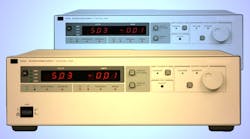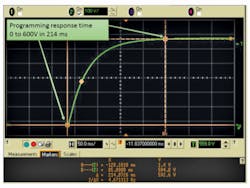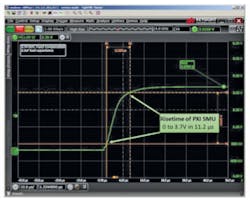This file type includes high-resolution graphics and schematics when applicable.
Simply put, dc power supplies are inherently analog devices. These feedback systems regulate dc voltage to a user-selected setpoint value. They can generate dc values, steps, ramps, and arbitrary waveforms. But with all that, they have a digital side as well.
A Brief History Lesson
Prior to the 1980s, programmable dc power supplies were basically power amplifiers. You could turn a knob to set the output voltage or use some kind of remote programming to set the output voltage.
The two most popular remote programming methods were resistance programming and analog programming. With resistance programming, you would apply a resistor to the programming port and the dc output would be proportional to the size of the resistor. With analog programming, an external analog signal was applied to the supply’s programming port. The dc output would be proportional to the analog programming signal.
For example, 0 to 10 V into the programming port would result in 0 to full-scale dc-rated output on the power supply’s output terminals. Furthermore, if you applied a variable signal, you could easily vary the output within the limit of the dc sources’ bandwidth, which were often in the tens or hundreds of hertz.
The Modern Programmable Supply
In the 1980s, companies like Hewlett-Packard pioneered the “One-Box Solution” power supply (Fig. 1). A single package integrated the analog programming signal and the power output.
Originally programmed with 16-bit GPIO, the most popular models were programmed over GPIB. By sending ASCII string commands over GPIB, the power supply could be digitally programmed to a specific value without the need for the analog programming signal, since the digital-to-analog converter (DAC) was built-in.
Modern DC Power
Today’s dc power supplies are, for the most part, very similar to the original 1980s vintage “One-Box Solutions.” In some cases, LAN or USB has replaced GPIB. Fundamentally, though, today’s supplies still accept ASCII strings, codified as standard SCPI for the most part. The modern supply accepts the ASCII strings, and then converts the ASCII to the right digital information to drive the output terminals to the desired programmed value.
Internally, the power supply will receive ASCII data into its programming input buffer. From there, the supply’s CPU will process the ASCII into internal digital format, adjust for calibration, and put the proper digital value on the DAC, which programs the output. This process takes time—called the command processing time—and it varies greatly among dc power supplies.
High-performance supplies can accept commands and process them in about 1 ms. Basic supplies will take 50 to 100 ms before the output will start to slew to the new programmed value. Older designs are typically slower, due to the slower speed of their processors. The latest designs, even for basic supplies, are typically between 10 to 50 ms, thanks to their high-speed CPUs.
Some supplies even run embedded operating systems, like Windows CE, which can deliver fast command processing while allowing instrument designers to take advantage of Windows features to give the power supply user an enhanced experience. Such enhancements include support of sophisticated communications over LAN and USB, data storage on USB thumb-drives, and complex graphical user interfaces.
Once the DAC is programmed, the digital job is done and now the analog power stage will slew to the new value, which makes the output voltage begin to change. This specification is referred to as the programming response time. Programming response time will be less than 1 ms for a fast supply and could be as slow as hundreds of milliseconds on a large, slow basic supply (Fig. 2).
PXI Power Supplies
While the majority of programmable dc power supplies are standalone boxes operating via ASCII SCPI over standard PC communications buses, some PXI power supplies also are available. These actually work a bit differently. Of course, the PXI supply has a DAC that provides the analog programming signal to the power output stage. Further upstream from the DAC, though, the PXI supply is quite different.
To achieve speed, the PXI supply will not have an on-board microprocessor. The DAC is fed digital info directly from the PXI backplane or from the backplane through some programmable logic, like an FPGA. There are neither ASCII commands nor SCPI. The communications interface is high-speed PCI or PCIe, rather than GPIB, USB, or LAN. The power-supply driver in the PC manages the programming instructions, which nearly instantaneously converts the desired programming voltage to the right DAC value before it’s sent to the PXI supply over PCI/PCIe. Thus, the speed of this digital side is significantly faster for a PXI power supply, clocking in at tens of microseconds instead of tens of milliseconds.
Does this mean that the speed advantage of PXI spells the end of ASCII SCPI-based control for dc power? The answer is no for two reasons. First, while the PXI control structure can be up to 1000 times faster, remember that the end device is a dc power supply. Most supplies can’t slew their output voltage faster than in 10 to 50 ms. As a result, blazingly fast PXI programming gets lost on the analog side of the supplies, leaving little benefit of PXI over standard ASCII over LAN (or USB or GPIB).
Second, dc supplies range in value from a few watts per output to tens or hundreds of kilowatts per output. The power for most dc power supplies exceeds the backplane power per slot of a PXI frame, which is about 30 W per slot. And physically, most supplies would not fit on a single-slot PXI card (or even on a card that occupies several slots). Therefore, the majority of supplies will be forced to exist outside the PXI mainframe.
PXI SMUs Go Fast in Digital and Analog
For low-power (less than 30 W), high-speed applications, specialized fast and accurate PXI power supplies, sometimes called source measure units or SMUs, are designed to take full advantage of the PXI speed and the convenient small form factor. PXI SMUs are a good choice in applications such as IC test, mobile-phone test, low-power IoT device test, and Bluetooth device test.
In Figure 3, the scope trace shows the programming response time of the Keysight M9111A PXI SMU as it slews from 0 to 3.7 V in 11.2 µs. The scope only captures the analog activity of the PXI SMU. Prior to the start of the voltage slew, the PXI driver in the PC, the PC-to-PXI frame communications, and the PXI backplane all had to do their digital job, which was benchmarked at about 40 µs. Ultimately, this fast PXI SMU can perform the digital and analog tasks fast enough to change voltage in about 50 µs.






